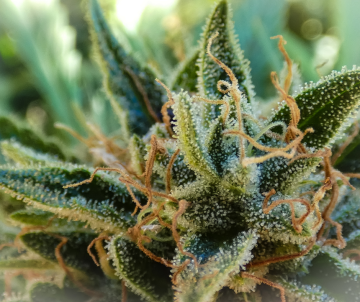Cannabis Trichomes Close Up

If youve ever seen cannabis plants under a macroscopic lens or under a microscope, then youve certainly noticed many translucent, glistening resin glands that protrude from both the flowers and basically the entire plant. Most experts know that these are "trichomes". The sticky layer of "trichomes" is home to all the active substances contained in cannabis plants.
The main ones are Tetrahydrocannabinol (THC), cannabidol (CBD) and other therapeutic cannabinoids. But have you ever wondered what exactly trichomes serve for the plant and why cannabis needs so much from a biological plant point of view?
Development
There has always been a general rule in nature that only a stronger one will survive.
" Trichomy"serves as a defense mechanism for most plants against a variety of potential enemies. The name" trichomes "is based on ancient Greek and means" hair growth "in essence. The sticky resin is a protective shield against enemy insect attacks, such as chemicals contained in these hairs, which make it harder to digest for animals and can also partially inhibit the growth of some types of mold. It also acts as a natural oprotection against UV-B rays of sunlight.

Cannabinoids
Cannabinoids are groups of compounds that naturally occur in cannabis plants and were first discovered in 1940. Under normal inhalation, these chemicals bind to cannabinoid CB1, CB2, and activate receptors in the human brain, causing euphoria in humans.
broader definitionIt includes three basic types of cannabinoids:
"Phytocannabinoids "which occur only in cannabis plants;
"endogenous cannabinoids" contained in human organs and other mammals, birds, fish and reptiles;
"sontetanic cannabinoids "which are related to artificially produced compounds in laboratories.
Kanabthe inoids present are already mentionedTHC, CBD, cannabinol (CBN), cannabichromene (CBC), cannabigerol (CBG) and tetrahydrocannabivarin (THCV).
Trichomes are not a sign of strength
Many independent sources say the strength and potential of todays cannabis has increased dramatically over the past 30 years. But one thing is certain. Higher amounts of "trichomes" do not necessarily mean higher cannabis potential and strength because tThe resin may or may not contain high levels THCand other mentally active substances. Some experts speculate whether the amount of "trichomes" is reflected in the amount of THC oils inside resin glands, but new studies show that other "cannabinoids" also have a significant effect on human brain functions.

Trichome species
Trichomes are found in many shapes and sizes, many plant species around the world.
The cannabis plant has developed three major species (from the Navajo Encyclopedia):
Bulky:
This type is the smallest (15 to 30 microns). One to four cells form the so-called "foot" and "stem" and four cells form the so-called "head" of the gland. The main cells secrete the resin, probably the cannabinoids and related compounds that accumulate between the head cells and the skin of the plant. When the gland matures, its protrusion can form a solid membrane from the pressure of the accumulated resin.
Grayscale kulovit:
The second type of gland is larger (25-100 microns) and is more numerous than bulbous glands. They are called "capitate", meaning they have a spherical head shape. On immature plants, the peaks in the unit liethey do not have a stem and are called English "capitate". The head usually consists of eight but sometimes up to 16 cells that form the so-called convex rosette. These cells secrete cannabinoids and related compounds that accumulate between the rosette and its outer membrane. This gives it a typical spherical shape.
Stonkový spherical:
Cannabinoids are the most abundant in these types of glands. During flowering, the enlarged glands appear mainly on the newly formed parts of the plants. Some glands are elevated to a height of 150 to 500 microns. These long stem glands appear during flowering and form their densest cover on the leaf surface covering the seeds of female plants. They are also highly concentrated on small leaves that accompany the inflorescence.
